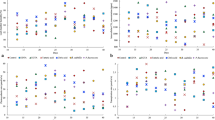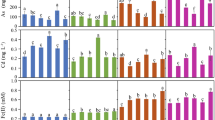Abstract
Excessive cadmium (Cd) in soils is a serious threat to food safety. Combinations of fungal endophytes and biochar have been shown to restrict Cd accumulation in crop plants, but the interactions of Paecilomyces variotii extracts (ZNC) and biochar on the remediation of alkaline Cd-contaminated soil remain unclear. This work aimed to study the Cd immobilization ability by amendment with ZNC and biochar via column experiments. The results indicated that ZNC alleviated the inhibition of Cd on photosynthesis of maize, thus supporting Cd resistance by growth promotion. Biochar promoted the conversion of exchangeable Cd into a less-available form, which reduced the content of DTPA-extractable Cd by 4.93 ~ 21.28% and − 0.83 ~ 19.51% in the 0–10- and 10–20-cm soil layers, respectively. The combination of biochar and ZNC substantially reduced Cd concentrations in maize plants, with more significantly lower grain Cd concentrations in higher biochar dosage treatments. These findings indicate that the combination of ZNC and biochar has significant potential to promote plant growth by altering Cd bioavailability and Cd tolerance in alkaline Cd-contaminated soil.







Similar content being viewed by others
Data availability
The datasets used and/or analyzed during the current study are available from the corresponding author on reasonable request.
References
Zhao F, Ma Y, Zhu Y, Tang Z, McGrath SP (2015) Soil contamination in China: current status and mitigation strategies. Environ Sci Techno l 49:750–759
Zama EF, Zhu YG, Reid BJ, Sun GX (2017) The role of biochar properties in influencing the sorption and desorption of Pb(II), Cd(II) and As(III) in aqueous solution. J Clean Prod 148:127–136
Yu X, Zhou H, Ye X, Wang H (2021) From hazardous agriculture waste to hazardous metal scavenger: tobacco stalk biochar-mediated sequestration of cd leads to enhanced tobacco productivity. J Hazard Mater 413:125303
Rai PK, Lee SS, Zhang M, Tsang YF, Kim KH (2019) Heavy metals in food crops: health risks, fate, mechanisms, and management. Environ Int 125:365–385
Zhang YC, Xiao X, Zhu XM, Chen BL (2022) Self-assembled fungus-biochar composite pellets (FBPs) for enhanced co-sorption-biodegradation towards phenanthrene. Chemosphere 286:131887
Jing FQ, Sohi SP, Liu YY, Chen JW (2018) Insight into mechanism of aged biochar for adsorption of PAEs: reciprocal effects of ageing and coexisting Cd2+. Environ Pollut 242:1098–1107
Arabia Z, Rinklebe J, El-Naggar A, Hou DY, Sarmah AK, Moreno-Jim’enezd E (2021) Immobilization of arsenic, chromium, and nickel in soils via biochar: a meta-analysis. Environ Pollut 286:117199
Qian GR, Chen W, Lim TT, Chui PC (2019) In-situ stabilization of Pb, Zn, Cu, Cd and Ni in the multi-contaminated sediments with ferrihydrite and apatite composite additives. J Hazard Mater 170:1093–1100
Tang N, Niu CG, Li XT, Liang C, Guo H, Lin LS (2018) Efficient removal of Cd2+ and Pb2+ from aqueous solution with amino and thiol functionalized activated carbon: isotherm and kinetics modeling. Sci Total Environ 635:1331–1344
Chen D, Guo H, Li RY, Li LQ, Pan GX, Chang A, Joseph S (2016) Low uptake affinity cultivars with biochar to tackle Cd-tainted rice-a field study over four rice seasons in Hunan, China. Sci Total Environ 541:1489–1498
Gul S, Whalen JK, Thomas BW, Sachdeva V, Deng HY (2015) Physicochemical properties and microbial responses in biochar-amended soils: mechanisms and future directions. Agric Ecosyst Environ 206:46–59
Jiang ZQ, Wang T, Sun YL, Nong Y, Tang LY, Gu TT, Wang SM, Li Z (2020) Application of Pb to probe the physiological responses of fungal intracellular vesicles. Ecotoxicol Environ Saf 194:110441
Awa SH, Hadibarata T (2020) Removal of heavy metals in contaminated soil by phytoremediation mechanism: a review. Water Air Soil Pollut 231(2):47
Etesami H (2018) Bacterial mediated alleviation of heavy metal stress and decreased accumulation of metals in plant tissues: mechanisms and future prospects. Ecotoxicol Environ Saf 147:175–191
Zare MR, Amin MM, Nikaeen M, Bina B, Rahmani A, Hemmati-Borji S, Rahmani H (2015) Acute toxicity of Hg, Cd, and Pb towards dominant bacterial strains of sequencing batch reactor (SBR). Environ Monit Assess 187:263
Xing YM, Wan YT, Liu YL, Wang PF, Zhao YX, Fan Z, Tian XF (2021) Effects of extracts from paecilomyces variotii on chlorophyll fluorescence transient in leaves of maize under waterlogging stress. J Irrig Drain 40:52–57
Wang XQ, Yao YY, Chen BC, Zhang M, Liu ZL, Wang Q, Ma JZ (2020) Paecilomyces variotii extracts and controlled-release urea synergistically increased nitrogen use efficiency and rice yield. ACS Omega 5:13303–13311
Gasco G, Alvarez ML, Paz-Ferreiro J, Mendez A (2019) Combining phytoextraction by Brassica napus and biochar amendment for the remediation of a mining soil in Rio Tinto (Spain). Chemosphere 231:562–570
Franchi E, Cosmina P, Pedron F, Rosellini I, Barbafieri M, Petruzzelli G, Vocciante M (2019) Improved arsenic phytoextraction by combined use of mobilizing chemicals and autochthonous soil bacteria. Sci Total Environ 655:328–336
Wang XQ, Yao YY, Liu ZG, Chen BC, Zhang M, Wang QB, Ma JZ (2021) Highly active biostimulant Paecilomyces variotii extracts reduced controlled-release urea application while maintaining rice yield. J Sci Food Agr 102:1883–1893
Chen Q, Li ZL, Qu ZM, Zhou HY, Qi YJ, Liu ZG, Zhang M (2020) Maize yield and root morphological characteristics affected by controlled release diammonium phosphate and Paecilomyces variotii extracts. Field Crop Res 255:107862
Hamid Y, Tang L, Hussain B, Usman M, Gurajala HK, Rashid MS, He ZL, Yang XE (2020) Efficiency of lime, biochar, Fe containing biochar and composite amendments for Cd and Pb immobilization in a co-contaminated alluvial soil. Environ Pollut 257:12
Ure AM, Quevauviller P, Muntau H, Griepink B (1993) Speciation of heavy metals in soils and sediments. Int J Environ Anal Chem 51:135–151
Clemente JS, Beauchemin S, MacKinnon T, Martin J, Johnston CT, Joern B (2017) Initial biochar properties related to the removal of As, Se, Pb, Cd, Cu, Ni, and Zn from an acidic suspension. Chemosphere 170:216–224
Liu L, Li W, Song W, Guo M (2018) Remediation techniques for heavy metal contaminated soils: principles and applicability. Sci Total Environ 633:206–219
Yin GC, Song XW, Tao L, Sarkar B, Sarmah AK, Zhang WX, Lin QT, Xiao RB, Liu QJ, Wang HL (2020) Novel Fe-Mn binary oxide-biochar as an adsorbent for removing Cd (II) from aqueous solutions. Chem Eng J 389:124465
Fan JJ, Cai C, Chi HF, Reid BJ, Coulon F, Zhang YC, Hou YW (2020) Remediation of cadmium and lead polluted soil using thiol-modified biochar. J Hazard Mater 388:122037
Rinklebe J, Shaheen SM (2015) Miscellaneous additives can enhance plant uptake and affect geochemical fractions of copper in a heavily polluted riparian grassland soil. Ecotox Environ Safe 119:58–65
Fellet G, Marmiroli M, Marchiol L (2014) Elements uptake by metal accumulator species grown on mine tailings amended with three types of biochar. Sci Total Environ 468–469:598–608
Janus A, Waterlot C, Heymans S, Deboffe C, Douay F, Pelfrene A (2018) Do biochars influence the availability and human oral bioaccessibility of Cd, Pb, and Zn in a contaminated slightly alkaline soil? Environ Monit Assess 190(4):218
Wang LW, O’Connor D, Rinklebe J, Ok YS, Tsang DCW, Shen ZT, Hou DY (2020) Biochar aging: mechanisms, physicochemical changes, assessment, and implications for field applications. Environ Sci Technol 54(23):14797–14814
Lu CC, Liu HF, Jiang DP, Wang LL, Jiang YK, Tang SY, Hou XW, Han XY, Liu ZG, Zhang M, Chu ZH, Ding XH (2019) Paecilomyces variotii extracts (ZNC) enhance plant immunity and promote plant growth. Plant Soil 441:383–397
Tu C, Wei J, Guan F, Liu Y, Sun YH, Luo YM (2020) Biochar and bacteria inoculated biochar enhanced Cd and Cu immobilization and enzymatic activity in a polluted soil. Environ Int 137:105576
Ren J, Wang FH, Zhai YB, Zhu Y, Peng C, Wang TF, Li CT, Zeng GM (2017) Effect of sewage sludge hydrochar on soil properties and Cd immobilization in a contaminated soil. Chemosphere 189:627–633
Qiu Z, Tang J, Chen J, Zhang Q (2020) Remediation of cadmium-contaminated soil with biochar simultaneously improves biochar’s recalcitrance. Environ Pollut 256:113436
Derakhshan Nejad Z, Rezania S, Jung MC, Al-Ghamdi AA, Mustafa A, Elshikh MS (2021) Effects of fine fractions of soil organic, semi-organic, and inorganic amendments on the mitigation of heavy metal (loid)s leaching and bioavailability in a post-mining area. Chemosphere 271:129538
Houben D, Sonnet P (2015) Impact of biochar and root-induced changes on metal dynamics in the rhizosphere of Agrostis capillaris and Lupinus albus. Chemosphere 139:644–651
Zhu Z, Huang Y, Wu X, Liu Z, Zou J, Chen Y, Su N, Cui J (2019) Increased antioxidative capacity and decreased cadmium uptake contribute to hemin-induced alleviation of cadmium toxicity in Chinese cabbage seedlings. Ecotoxicol Environ Saf 177:47–57
De Maria S, Puschenreiter M, Rivelli AR (2013) Cadmium accumulation and physiological response of sunflower plants to Cd during the vegetative growing cycle. Plant Soil Environ 59:254–261
Xiao X, Chen ZM, Chen BL (2020) Proton uptake behaviors of organic and inorganic matters in biochars prepared under different pyrolytic temperatures. Sci Total Environ 746:140853
Kamran M, Malik Z, Parveen A, Zong YT, Abbasi GH, Rafiq MT, Shaaban M, Mustafa A, Bashir S, Rafay M, Mehmood S, Ali M (2019) Biochar alleviates Cd phytotoxicity by minimizing bioavailability and oxidative stress in pak choi (Brassica chinensis L) cultivated in Cd-polluted soil. J Environ Manag 250:109500
Wang RZ, Wei S, Jia PH, Liu T, Hou DD, Xie RH, Lin Z, Ge J, Qiao YB, Chang XY, Lu LL, Tian SK (2019) Biochar significantly alters rhizobacterial communities and reduces Cd concentration in rice grains grown on Cd-contaminated soils. Environ Sci Technol 676:627–638
Wang RZ, Wei S, Jia PH, Liu T, Tian SK (2019) Biochar significantly alters rhizobacterial communities and reduces Cd concentration in rice grains grown on Cd-contaminated soils. Sci Total Environ 676:627–638
Huang YF, Chen JH, Zhang DR, Fang B, Yangjin T, Zou JW, Chen YH, Su NN, Cui J (2021) Enhanced vacuole compartmentalization of cadmium in root cells contributes to glutathione-induced reduction of cadmium translocation from roots to shoots in pakchoi (Brassica chinensis L). Ecotoxicol Environ Saf 208:111616
Nakamura S, Suzui N, Yin YG, Ishii S, Fujimaki S, Kawachi N, Rai H, Matsumoto T, Sato-Izawa K, Ohkama-Ohtsu N (2020) Effects of enhancing endogenous and exogenous glutathione in roots on cadmium movement in Arabidopsis thaliana. Plant Sci 290:110304
Funding
This study was supported by the Natural Science Foundation of China (grant no. 41807092), the Open Project of Liaocheng University Animal Husbandry Discipline (no. 319312101–18), the Project of Shandong Province Higher Educational Science and Technology Program (KJ2018BAF034), and the Startup Foundation for Ph.D. of Liaocheng University (318051839).
Author information
Authors and Affiliations
Contributions
Xinran Guo took part in data curation, investigation, and original draft writing; Jiyao Xu took part in methodology and material preparation; Dongyu He and Derui Bu involved in data collection and analysis; Yanyan Lu took part in formal analysis; Youxin Zhao and Yurong Chen took part in review and editing; Xiaofei Tian took part in conceptualization, writing—review and editing.
Corresponding author
Ethics declarations
Ethics approval
Not applicable.
Consent to participate
Not applicable.
Consent for publication
Not applicable.
Competing interests
The authors declare no competing interests.
Additional information
Publisher's note
Springer Nature remains neutral with regard to jurisdictional claims in published maps and institutional affiliations.
Supplementary Information
Below is the link to the electronic supplementary material.
Rights and permissions
Springer Nature or its licensor holds exclusive rights to this article under a publishing agreement with the author(s) or other rightsholder(s); author self-archiving of the accepted manuscript version of this article is solely governed by the terms of such publishing agreement and applicable law.
About this article
Cite this article
Guo, X., Xu, J., He, D. et al. Combining paecilomyces variotii extracts and biochar for the remediation of alkaline Cd-contaminated soil. Biomass Conv. Bioref. (2022). https://doi.org/10.1007/s13399-022-03308-0
Received:
Revised:
Accepted:
Published:
DOI: https://doi.org/10.1007/s13399-022-03308-0




